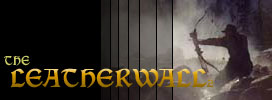| From: Stumpkiller
|
|
|
|
|
|
|
| Date: 25-Jan-11 |
|
In the past week it's been ugly cold so I added some complication to my simple spine tester. By scrounging I came up with a clothespin, an old thumb knurled bolt from a "glory jar", a toggle link made of a bent nail, two nylon ties, a bamboo skewer, a #6 machine screw and three washers, a piece of pine to hold the scale, a piece of cereal box cardboard to mark the scale on and a piece of poplar to bolt the clothespin to. By adding these to the two 1/2" dowels 26" apart on the sheld (aready there) I now have a direct reading spine scale that shows deflection in 1/20 of an inch graduations (0.0, 0.05, 0.10, 0.15 etc.) I can ballpark the in between values well enough for my purposes. For the deflection to spine values I downladed a table from Rose City Archery's website.
So, what's it look like?
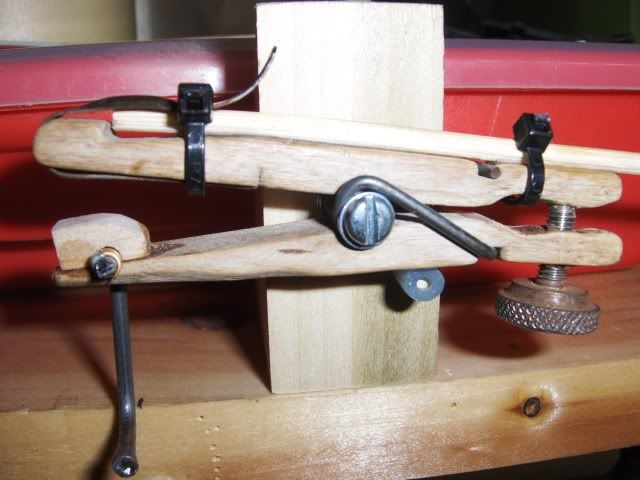
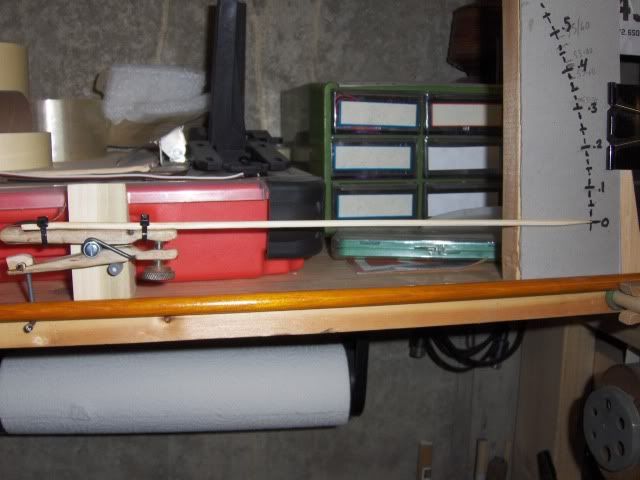
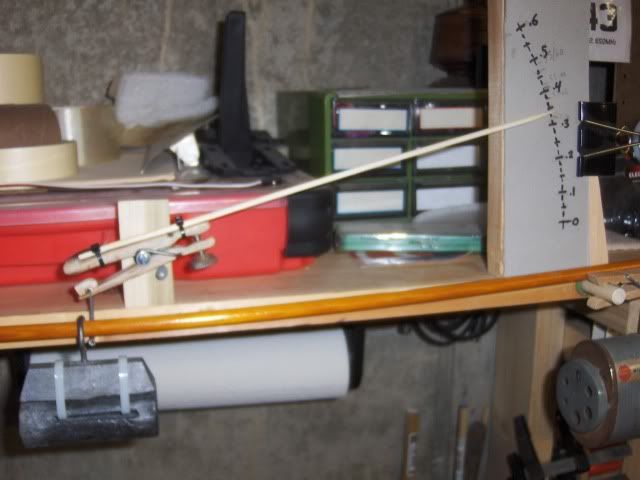 ] ]
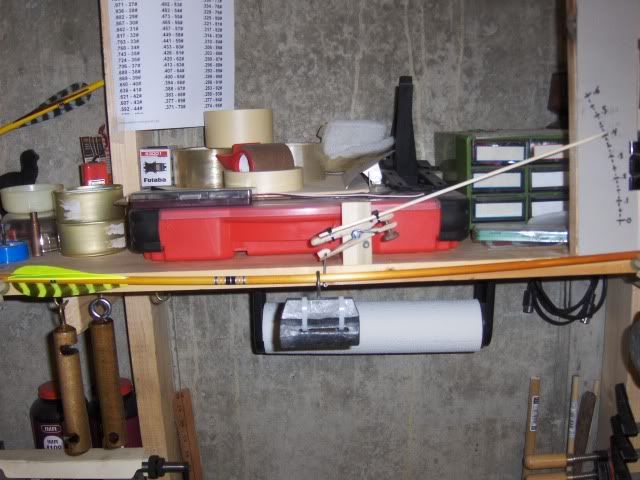

The time consuming part was calibrating the scale. First I moved the adjustment screw in the jaws of the clothespin until it was mid-range. (This will allow me to zero the scale for different diameter or tapered shafts . . .Ooooooo!). I used a vernier caliper and a pair of "T" pins. I set the first pin under the shaft without the 2# weight on as a zero mark. Then I measured down 1/10th of an inch and carefully placed a second "T" pin. Pulling the first pin and pushing the shaft down I then marked the scale. I repeated this until I had all the 1/10" graduations. Then I scientifically added the arc of movement on the scale by moving the clothespin around and ticking off the cardboard where the tip was. I measured 1/2 of those distances (Hey, they were evenly spaced at 0.9" between - I must have been close enough to accurate) to give me the 1/20" ticks.
You can see a few shafts I measured - right where they should be! Be sure to set the grain vertical with woodies (that gives the stiffest reading). Sounds obscene.
Two little bits that may not be obvious - I put a little piece of dowel under the clothespin so at rest it doesn't swing fully down. This makes it easier to lay a shaft in and will protect it from casual damage. The other is that the link is a "C" shaped with right angle bends. It's a finishing nail with a bit of balse to trap it to the clothespin. Free swinging; I silver-soldered a few turns of wire to it to trap it in place. The clothespin is bolted to a triangle of wood that is in turn screwed to the shelf. Just one screw so I could twist it to get the best clearance on the scale (close but not touching. The clothespin is held to the block by a #6 machine screw just threaded into the block after drilling a small pilot hole. One washer on the outer side and two inner gave good clearance.
There you have it. I've been spining arrows and getting some surprises . . . but mostly they're where I expected.
Enjoy.
PS - the original 2# weight goes at the 13" mark and is just an opened screw eye threaded into lead ingots. Once I was happy with the bamboo pointer I used Instant Glue to fix it to the clothespin. Also used that to strengthen the screw threads - with the screws out until it dries!
|
|
| From: Quiet Man
|
|
|
|
|
|
|
| Date: 26-Jan-11 |
|
Thats just plain all right, love the zero adjustment.
|
|
| From: capsmith
|
|
|
|
|
|
|
| Date: 26-Jan-11 |
|
Goo job, I like it.
|
|
| From: Stumpkiller
|
|
|
|
|
|
|
| Date: 27-Jan-11 |
|
Thanky. Working up a better defined scale for it now. I went through 40 shafts a few nights ago and had a few surprises it what were supposed to be spine matched groups. The zero feature makes all the difference - you could use a wood wedge in the clothespin jaws for the same adjustability.
|
|
| From: aromakr
|

|
|
|
|
|
|
| Date: 30-Jan-11 |
|
One problem I see, it seems that your marks are evenly spaced on the scale? That's not how it works. Spine is based on a math formula [deflection divided into 26 = bow weight]. As the shafts get stiffer the marks are closer together and as the shaft weakens they move further apart. Example the deflection difference between 70# .371 and 75# .347 is only .024 but the difference between 30# .866 and 35#.742 the difference is 124. There is 6# difference in each of those shafts, but a huge difference is spread. And I'm not sure I like the clothespin idea, you might be getting some flexing from the 2# weight. Just some thoughts. Bob
|
|
| From: Stucky
|
|
|
|
|
|
|
| Date: 11-Oct-16 |
|
Where can I get the formula for the proper spacing layout? Is the arc based on a circle or is it derived from the same formula?
Also, I thought standard was 28". Why would you space the arrow at 26"?
|
|
| From: Bender
|
|
|
|
|
|
|
| Date: 11-Oct-16 |
|
Stucky, wooden arrows are still measured using the AMO standard which called for measuring deflection by setting the arrow on rests spaced 26" apart and applying a 2# weight.
The synthetics are measured using the ASTM standard which calls for measuring deflection by setting the arrow on rests spaced 28" apart and applying a 1.94# weight.
As to WHY there are 2 standards, well, that is just one of those mysteries of life. Nobody really seems to know.
|
|
| From: MStyles
|
|
|
|
|
|
|
| Date: 12-Oct-16 |
|
Very clever.
|
|
| From: limbwalker
|
|
|
|
|
|
|
| Date: 12-Oct-16 |
|
Rube Goldberg's got nothing on you!
Good job!
|
|
| From: Tracker7
|
|
|
|
|
|
|
| Date: 12-Oct-16 |
|
Just a thought. ....first off thank you for the great explanation and pics. Regardless of the scale graduations...are we not looking for shafts of near equal spine? I think this home brewed tester would do it! It's always about the journey! Your love of this sport shows. Thanks again.
|
|
| From: Osr144
|
|
|
|
|
|
|
| Date: 13-Oct-16 |
|
Looks good you did a great job.My spine tester only has my various bows marked on my scale.I can't give you actual numbers as my scale is set to a master shaft.When I find a arrow that shoots as close to perfect as can be for a particular bow I spine all my arrows to match that.Numbers don't really come in to it for me but actual performance is what matters.In one way Bob is right but I am sure you would still get exceptable results.as long as you have some base figure to work off any variation could be taken into account.I just make my spine meters as I need them but I would be lost with out my master arrows .Yeah I also make simple balance scales to weigh my shafts too.my shafts are measured in coin weight.On average most of my footed shafts weigh 11 Australian 5 cent pieces .your meter looks awesome and in my opinion should serve you well. OSR
|
|
| From: Jim Davis
|
|
|
|
|
|
|
| Date: 13-Oct-16 |
|
You have the marks correctly spaced. You area not reading spine, you are reading deflection. You then look at a scale that has deflection beside the corresponding spine rating. Some, if not most spine testers have such a double scale.
You are good to go, and nicely done, I say. I use a dial indicator. I think your setup would be easier to use than mine, but mine is easier to store, and it stays stored more than it is in use. :)
Jim
|
|
If you have already registered, please sign in now
For new registrations Click Here
|
|
|
|

